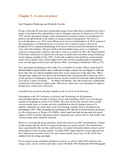A crisis in power

View/
Date
2005Author
Wakhungu, Judi Wangalwa
Cecelski, Elizabeth
Language
enMetadata
Show full item recordAbstract
Energy is not only a basic need in itself, but is required for services, such as transport, industrialization, education, health, water, and communications, that release people from time- and energy-consuming tasks and allow them to turn to more productive activities. Women’s role at the centre of the “rural energy crisis” — as users, producers, victims, and activists — as well as in meeting the family’s basic needs has been well documented (Cecelski 1992). However, women are also pivotal in the urban energy situation.
Women have been portrayed as subsistence users of biomass energy in rural and urban stove-improvement programs. In the 1980s, with the realization that household chores, specifically cooking, consume the largest portion of total energy (especially biomass energy) in low-income, developing countries, women became the target group for achieving major fuel savings. Initially, however, many improved-stove programs failed, largely because of the tendency to seek universal “technical fixes” rather than analyzing local and national fuel use and supply conditions. Data were frequently based on the limited knowledge of men, and male engineers designed stoves without consulting the women who would have to use them. Many professional technologists found it difficult to elicit, acknowledge, use, or respect women’s traditional knowledge and expertise regarding the properties of fuels, food preparation, stove construction, and community education — all so relevant for successful stove design and dissemination (Kammen and Lankford 1991; McGranahan and Kaijser 1993).
